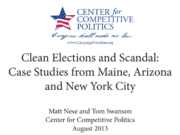No matter how many times we set the record straight, it seems we just can’t rid the world of myths surrounding tax-financed campaigns (for an introduction to tax-financed campaigns, see here). The latest comes from an opinion piece in the Huffington Post by a tax-financing advocate, who claims that New York State will actually save money if it starts a program to give taxpayer dollars to politicians in a Dec. 1 article titled “Spending $60 Million to Save $1 Billion.”
As we’ve explained before, tax-financed campaigns are not a new idea, and they do not save taxpayer dollars. Arizona and Maine have had tax-financed campaigns for all legislative races since 2000, and government spending has risen since that time in both states. In fact, Arizona saw its average annual spending growth rate more than double under tax-financed campaigns.
The article, written by Citizen Action of New York’s Executive Director, Karen Scharff, does not cite any evidence from existing tax-financed campaign programs to support its bold claim. All Ms. Scharff points to are instances of government giving handouts to large corporations, and hope that a tax-financing program will put a stop to it.
It won’t. A CCP study of voting records in the Connecticut legislature determined that after the state implemented tax-financing in 2008, there was no change in how often participant legislators voted with organized interests. A Goldwater Institute study of Arizona’s system found no difference in voting behavior between candidates who used the tax-financing program and those who did not. In Maine, lobbyist registrations have increased since the implementation of tax-financed campaigns in 2000, and Arizona recorded its highest number of lobbyist registrations ever as recently as 2010. Put simply, tax-financed campaigns don’t put an end to special interest influence. They don’t even put down a speed bump.
Rather than curing corruption, tax-financed campaigns actually open up new avenues for corruption and abuses of public funds. CCP has documented a laundry list of corruption charges against candidates that have received public funds to run for office in Arizona, Maine, and New York City. From 2001 to 2013, over $19 million in tax dollars was provided to so-called “clean” candidates in New York City alone, who were later investigated for corruption and other misuses of public funding – entire campaigns have been fabricated just to steal money from the public. Of course, it bears mention that advocates for tax-financing in New York State like Ms. Scharff point to New York City’s program as a model for the Empire State.
Ms. Scharff does not make any estimates of how much New York State can expect to give away to corrupt politicians. In her fantasy world, tax-financing would eliminate corrupt politicians, end giveaways to corporations, and maybe make ice cream free on weekends too. Hey, why not?
Unfortunately, outside the fantasy realm of Ms. Scharff’s mind is the real world, where tax-financed campaign programs have overwhelmingly failed to achieve their stated goals of reducing corruption and improving government. Even worse, if Ms. Scharff is correct that tax-financing will cost New York State roughly $60 million at its outset, it would only get worse from there. Tax-financed campaign programs have a proven record of growth and expansion. The New York City program, which Ms. Scharff alludes to, started by matching small contributions dollar for dollar. It now matches each dollar in small contributions with six dollars in tax funds.
Throwing away $60 million on a useless and ineffective program is appalling enough. Throwing away $360 million would be a tragedy. New Yorkers deserve the facts before they’re stuck with the bill.














